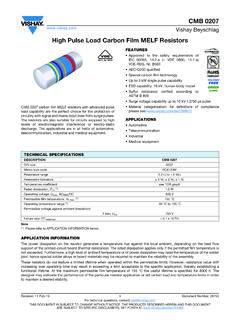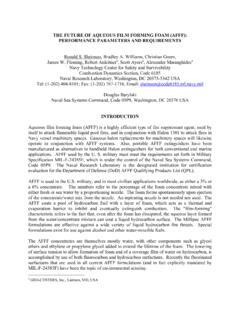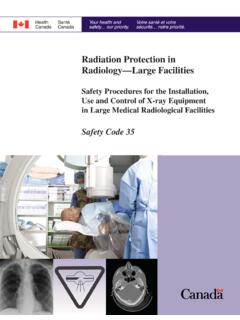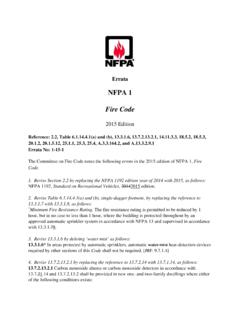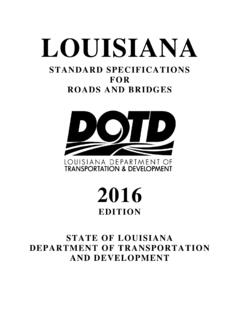Transcription of Radiation protection supervisors - HSE
1 IntroductionThis HSE information sheet is aimed at radiationemployers, Radiation protection advisers (RPA), radiationprotection supervisors (RPS), safety representatives andworkers. It gives advice on the level of knowledge andmanagement responsibility that would make a personsuitable for appointment as an RPS under regulation17(4) of the Ionising Radiations Regulations 1999(IRR99)1and builds on the guidance in the ApprovedCode of Practice2(L121, paragraphs 289-295). Role of RPS The RPS has a crucial role to play in helping to ensurecompliance with the arrangements made by the radiationemployer under IRR99 and, in particular, supervising thearrangements set out in local rules.
2 The legalresponsibility for supervision, however, remains with theradiation employer. The RPS will generally be an employee of the radiationemployer, although this is not a legal requirement. Theywill usually be in a line management position, closelyinvolved with the work being done, to allow them toexercise sufficient supervisory authority. In somesituations, for example where a contractor is undertakingwork on the site of another employer, it may beappropriate to appoint one of that site employer semployees as the RPS. Such an appointment might beappropriate where the site employer is a radiationemployer and the contractor rarely undertakes work withionising Radiation and may need to be confirmed bysuitable contractual arrangements.
3 It may not always be necessary for an RPS to bepresent all the time. In deciding how many RPSs arerequired, the Radiation employer will need to takeaccount of the range and complexity of the work that issubject to local rules and the number of differentlocations to be covered (see L121, paragraph 293).In some large establishments the RPS may not be theimmediate line manager or supervisor overseeing thework with ionising Radiation . In these cases a systemshould operate, which may involve more than oneperson, to ensure that adequate supervision ismaintained. In all cases the Radiation employer shouldprovide sufficient resources and managerial support toallow the RPS to operate effectively.
4 It is good practice,though not a legal requirement, to confirm theappointment in writing and to provide sufficientinformation about the individual s role. Radiationemployers may find it helpful to involve their RPAs in theselection, appointment and training of for RPSThe Radiation employer has a specific duty to provideappropriate training for all employees working withionising Radiation (see regulation 14). For RPSs, thepurpose of such training is to ensure that they knowenough about Radiation protection principles andprocedures, the requirements of the Regulations and thearrangements in local rules to enable them to supervisethe work safely and maintain the precautions that willrestrict exposure.
5 The length of the training, including refresher training,depends upon the experience of the RPS and thecomplexity of the work being undertaken. At oneextreme, as little as a few hours of specific training, egfrom the RPA, may be sufficient. In other circumstances(if the nature of the employer s business is complex andthe RPS has not already completed any form of radiationprotection training) a longer course of perhaps a fewdays duration may be necessary. However, it may beeconomical to provide a thorough training course for agroup of RPSs, only parts of which would be of directrelevance to the individuals. Some situations mayrequire a wider background knowledge of radiationprotection than the minimum suggested here.
6 It is for theradiation employer to decide, in the light also of advicefrom their RPA, how much training is needed inindividual cases and how to provide level of competence for RPS Employers should satisfy themselves that the peoplethey appoint to act as RPSs: lhave received appropriate information andinstruction as required under regulation 14;lknow and understand the requirements of theRegulations and Approved Code of Practice(L121), local rules and contingency plans relevantto the work with ionising Radiation ;lpossess sufficient authority to allow them tosupervise all the Radiation protection aspects of thework in areas subject to local rules;lknow what to do in an emergency; and lknow where to seek more information or modulesThe modules that follow comprise a basic level ofknowledge or expertise (core of competence) for anRPS.
7 The degree of detail that each module shouldprovide will depend on the range of tasks to besupervised and the individual s previous level of relevantknowledge. There is no significance to the order of thepresentation of the modules. Radiation protection supervisorsHSE information sheetIonising Radiation protection Series No 6 Core of competence for RPS modulesNB: For completeness, the core of competencesuggested here may include information that all radiationworkers should receive. 1 The nature of ionising Radiation and its interactionwith tissue - confined to those types of ionising radiationwhich may be encountered, but including:lthe nature of any harmful effects; lthe principle of restricting exposure to ionisingradiation so far as reasonably practicable; andlthe concepts of internal and external radiationexposure.
8 2 The quantities used for:lmeasuring ionising Radiation , including the units ofmeasurement;lactivity of radioactive substances; andlcontamination; as appropriate to the A detailed understanding of all dose quantities maynot be needed, provided there is an understanding ofwhat is meant by the general term dose of ionisingradiation . 3 Relevant measurement techniques (ie those thatwill be met in the course of normal work), for example:lfilm badge;lthermo-luminescent dosemeter (TLD);lelectronic dosemeter;lother personal dosemeter;lbioassay;lair sampling; and lworkplace portable monitors for Radiation and contamination. 4 Basic legal requirements:lthe Ionising Radiations Regulations 1999 (IRR99)and Approved Code of Practice (L121);llocal rules, their purpose and how to use them tosecure compliance with the Regulations;lrisk assessments; lprovisions specific to women and young people; ldesignation of people and areas; andlappreciation of relevant general health and safetylegislation, such as the Management of Health andSafety at Work Regulations The basic principles of practical radiationprotection:ltime;ldistance;lshi elding;lcontainment; and lgood housekeeping.
9 And how those principles are carried through in theparticular work In-house knowledge, as appropriate:lthe Radiation employer s safety policy andorganisation;lthe specific functions the RPS would be expectedto undertake;lrelevant dose limits;loperational levels set by the employer for theparticular workplace;lcontent of the local rules established by theradiation employer; lcontingency plans; andlwhere help and advice can be Practical procedures to be followed in the event ofan accident, incident, emergency or other unwantedoccurrence, including procedures for reporting adverseincidents. Relevant reading1 Ionising Radiations Regulations 1999SI1999/3232 Stationery Office 2000 ISBN 0 11 085614 72 Work with ionising Radiation .
10 Ionising RadiationsRegulations 1999. Approved Code of Practice andguidance L121 HSE Books ISBN 0 7176 1746 7 While every effort has been made to ensure theaccuracy of the references listed in this publication, theirfuture availability cannot be informationHSE priced and free publications are available by mailorder from HSE Books, PO Box 1999, Sudbury, SuffolkCO10 2WA. Tel: 01787 881165 Fax: 01787 : priced publications are also available from goodbooksellers. The Stationery Office (formerly HMSO) publications areavailable from The Publications Centre, PO Box 276,London SW8 5DT. Tel: 0870 600 5522 Fax: 0870 6005533. They are also available from other enquiries ring HSE's InfoLine Tel: 08701545500, or write to HSE's Information Centre, BroadLane, Sheffield S3 7HQ.











